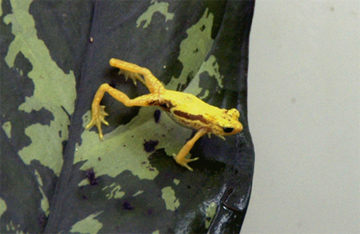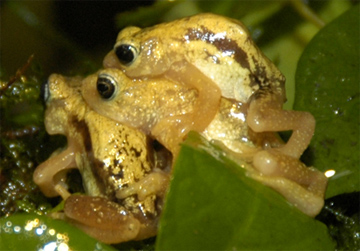Yellow toad births offer hope for extinct-in-the-wild species
Yellow toad births offer hope for extinct-in-the-wild species
Rhett A. Butler, mongabay.com
September 4, 2008
The birth of Kihansi spray toadlets at the Wildlife Conservation Society’s Bronx Zoo has renewed hopes that the species can someday be successfully reintroduced to its natural habitat in a remote gorge in Tanzania.
The Kihansi spray toad is believed to have been driven to extinction by the destruction of its only known habitat — the Kihansi gorge in the Southern Udzungwa Mountains of South Central Tanzania — by a hydroelectric project. Its demise was hastened by the appearance of the deadly chytrid fungus, a pathogen that is taking a heavy toll on amphibians around the world. The last confirmed sighting of the species in the wild was in May 2005.

|
Anticipating the impact of the dam, conservationists worked with the Tanzanian government to establish a captive breeding program for the species, but the program was initially fraught with difficulties associated with a particularly fragile species, including disease. By the spring of 2004, the worldwide captive population of the Kihansi spray toad was down to 70.
Since then the outlook for the species has been improving. A captive breeding program by the Bronx Zoo has brought the facility’s population up to 300 toads, including the dozen born last week (unlike most other amphibians, spray toads have live birth, rather than laying eggs). Kihansi spray toads are now also breeding successfully elsewhere.
WCS says it plans to work with Tanzania to return some of the captive toads to their habitat where a sprinkler system has been installed to counter the ecosystem changes caused by the hydroelectric dam. Reintroduction will require complete eradication of the chytrid fungus from the gorge.
Still while it looks increasingly likely that the Kihansi spray toad has escaped its brush with extinction, amphibians are still in big trouble worldwide. According to the recent Global Amphibian Assessment, about a third of amphibians are threatened with extinction. Pollution, the introduction of alien species, habitat destruction, over-collection, climate change, and the emergence of the pathogenic chytrid fungus have driven more than 170 species to extinction over the past two decades.
In an effort to save the most at-risk species, last year saw the launch of the Amphibian Ark, an initiative by zoos, aquariums, and botanical gardens to establish captive populations for 500 species.
Related

|
Toad on brink of extinction, scientists race to study amphibian for bioactive compounds
(06/29/2005) Under the bright florescent lights of the reptile house in the Bronx Zoo of New York, a colorful exotic toad makes its final stand. Once gathering by the thousands at the waterfalls of the Kihansi Gorge of Tanzania, the population of the Kihansi Spray Toad now stands at less than 200 individuals. The hasty construction of a desperately needed dam, built with good intentions by the World Bank, has relegated this species to the edge of existence. A decade ago the Kihansi Spray Toad thrived in its thoroughly unique habitat, the waterfalls of the Kihansi River, part of ecosystem that is one of only 25 Global Biodiversity Hotspots on the planet (Hotspots are regions noted for their extensive range of species in a very small area). The gorge is located in the Southern Udzungwa Mountains of South Central Tanzania, which possess the greatest biodiversity in all of Tanzania.
Amphibians face mass extinction
(8/11/2008) Amphibians are in big trouble. At least one third of the world’s 6,300 known species are threatened with extinction, while at least 200 species have gone extinct over the past 20 years. Worryingly the outbreak of a deadly fungal disease, chytridiomycosis, is spreading throughout the tropics leaving millions of victims. A new study, published in the early edition of the Proceedings of the National Academy of Sciences, warns that there is “little time to stave off a potential mass extinction” of frogs, salamanders, and caecilians.
Photos: Top 100 most threatened amphibians named
(1/21/2008) Due to numerous factors–including habitat destruction, pollution, climate change, and chytrid fungus–amphibians are probably the most threatened taxon of species in the world. Dr Jonathan Baillie, head of the EDGE organization which has just established an amphibian program, stated that “tragically, amphibians tend to be the overlooked members of the animal kingdom, even though one in every three amphibian species is currently threatened with extinction, a far higher proportion than that of bird or mammal species.” To help save these species on the brink, EDGE, apart of the Zoological Society of London, has compiled a list of the hundred most threatened and evolutionary distinct amphibians.
As amphibians leap toward extinction, alliance pushes “The Year of the Frog”
(12/31/2007) With amphibians experiencing dramatic die-offs in pristine habitats worldwide, an alliance of zoos, botanical gardens and aquariums has launched a desperate public appeal to raise funds for emergency conservation measures. Scientists say that without quick action, one-third to one-half the world’s frogs, toads, salamanders, newts and caecilians could disappear.
 |
Bad news for frogs; amphibian decline worse than feared
(4/16/2007) Chilling new evidence suggests amphibians may be in worse shape than previously thought due to climate change. Further, the findings indicate that the 70 percent decline in amphibians over the past 35 years may have been exceeded by a sharp fall in reptile populations, even in otherwise pristine Costa Rican habitats. Ominously, the new research warns that protected areas strategies for biodiversity conservation will not be enough to stave off extinction. Frogs and their relatives are in big trouble.










